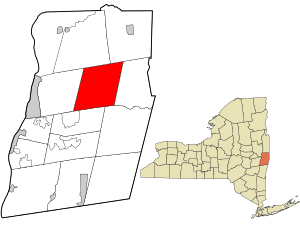Grafton, New York
| Grafton, New York | |
|---|---|
| Town | |
 Location in Rensselaer County and the state of New York. |
|
| Coordinates: 42°46′14″N 73°27′15″W / 42.77056°N 73.45417°W | |
| Country | United States |
| State | New York |
| County | Rensselaer |
| Area | |
| • Total | 45.96 sq mi (119.04 km2) |
| • Land | 44.72 sq mi (115.83 km2) |
| • Water | 1.24 sq mi (3.21 km2) |
| Elevation | 1,440 ft (439 m) |
| Population (2010) | |
| • Total | 2,130 |
| • Estimate (2016) | 2,161 |
| • Density | 48.32/sq mi (18.66/km2) |
| Time zone | Eastern (EST) (UTC-5) |
| • Summer (DST) | EDT (UTC-4) |
| ZIP code | 12082 |
| Area code(s) | 518 |
| FIPS code | 36-29674 |
| GNIS feature ID | 0979010 |
Grafton is a town in Rensselaer County, New York, United States. The population was 2,130 at the 2010 census. It is believed that the town received its name from Grafton, Vermont, from where the first town supervisor, Nathaniel Dumbleton, was originally from. The town is an interior town near the north-central part of the county. NY Route 2 passes across the town.
Grafton is notable for having a Peace Pagoda, built by Nipponzan Myohoji buddhist order in 1993.
The town of Grafton was originally a part of the Manor of Rensselaerswyck, and at that time was known as Roxborough. The first settlements are not clear from the ca. 1765-1807 map of the manor. As part of Rennesselaerswyck, the first inhabitants were renters of that estate.
The question of the first settlement of Grafton has never been settled. The names of the first white men who built new homes in the wilderness and the date of their coming probably will never be known. In all probability, however, the town was the last in Rensselaer County to be settled. Grafton was formed from the towns of Troy and Petersburgh on March 20, 1807, and even at this comparatively late day it had few inhabitants. Abel Owen is generally believed to have been the first man to enter the rather unattractive mountain wilderness and build himself a home. he was a sturdy farmer, an indefatigable laborer, and to encourage further settlement the patroon, Stephen Van Rensselaer III, gave him a grant of 200 acres (81 ha) or more of what was then thought to be the best land in that section adapted to farming. Owen was not long without neighbors, if indeed there were not one or more families located in that vicinity when he built his log house.
There is nothing to show when Mr. Owen moved to Grafton, but from subsequent settlements and other occurrences it is thought that it could not have been very long after the Revolutionary War. Possibly it was several years later, during that war or at its close. Immediately after the period when the colonists were fighting for independence, or beginning with 1784 or 1785, several families leased land in Grafton from the patroon and began the cultivation of the land there. Abel Owen is recorded as a Revolutionary soldier, so that the preponderance of opinion is that no settlements were made in the town until the closing years of the war or later. perhaps those who locacted there in the years mentioned accompanied Owen. About 1786 the latter had at least two or three neighbors, families names Coon and Demmon being early lessees of the patroon's lands. About 1796 Abel own sold his farm to Lemuel Steward and removed with his family to Onondaga County.
...
Wikipedia
